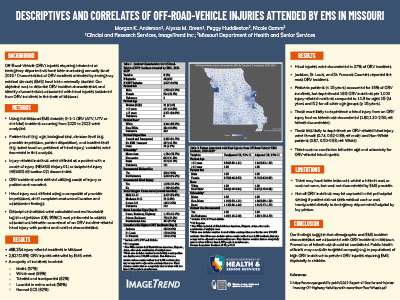ABSTRACTS
Descriptives and Correlates of Off-Road-Vehicle Injuries Attended by EMS in MissouriAuthor: Morgan Anderson, Alyssa M. Green, Peggy Huddleston, and Nicole Gamm | | Associate Authors:
Introduction: Off-road-vehicle (ORV) injuries requiring treatment at emergency departments have been increasing annually since 2016. Characteristics of ORV (all-terrain vehicle [ATV], utility vehicle [UTV], or dirt bike) incidents attended by emergency medical services (EMS) have been minimally studied. Objective: To describe ORV incidents and identify characteristics associated with head injuries sustained from ORV incidents in the state of Missouri. Methods: Using the Missouri EMS dataset, we analyzed 9-1-1 ORV incidents occurring between January 1, 2020, and December 31, 2023. Patient-level (e.g., age, biological sex), clinician-level (e.g., provider impression, patient disposition), and incident-level (e.g., scene location, presence of head injury) variables were examined. Injury-related incidents were defined as a patient with a documented cause of injury (NEMSIS eInjury.01) or suspected injury (NEMSIS eSituation.02). ORV incidents were defined utilizing cause of injury or patient-care narrative. Head injury was defined using provider impressions, chief complaint, anatomical location, and assessment findings. Descriptive statistics and multivariable logistic regression (odds ratio [OR], 95% CI) were calculated to assess associations between occurrence of ORV incident–related head injuries and patient and incident characteristics. Results: Of 488,254 injury-related incidents, 2827 (0.6%) ORV injuries were analyzed. A majority of incidents involved males (67%), White race (89%), treated and transported (82%), located in metro areas (56%), and normal GCS (92%). Head injuries were documented in 37% of ORV incidents. Pediatric patients (< 15 years) accounted for 16% of ORV incidents but experienced 18.6 ORV incidents per 1000 injury-related incidents compared to 11.9 for ages 15 to 24 years and 5.2 for all other age groups (≥ 15 years). Those more likely to experience a head injury from an ORV incident had no helmet use documented (OR = 1.80, 95% CI = 1.30–2.50; ref. helmet documented). Those less likely to experience an ORV-related head injury were female (OR = 0.74, 95% CI = 0.62–0.89; ref. male) and non-White (OR = 0.67, 95% CI = 0.50–0.88; ref. White). There was no correlation between age and urbanicity for ORV-related head injuries. Conclusion: Our findings suggest that demographic and EMS incident characteristics are associated with ORV incidents in Missouri. Promotion of helmet use should be considered. Public health officials may consider targeted campaigning in populations of high ORV incidence to prevent ORV injuries requiring EMS, especially in children.
|

